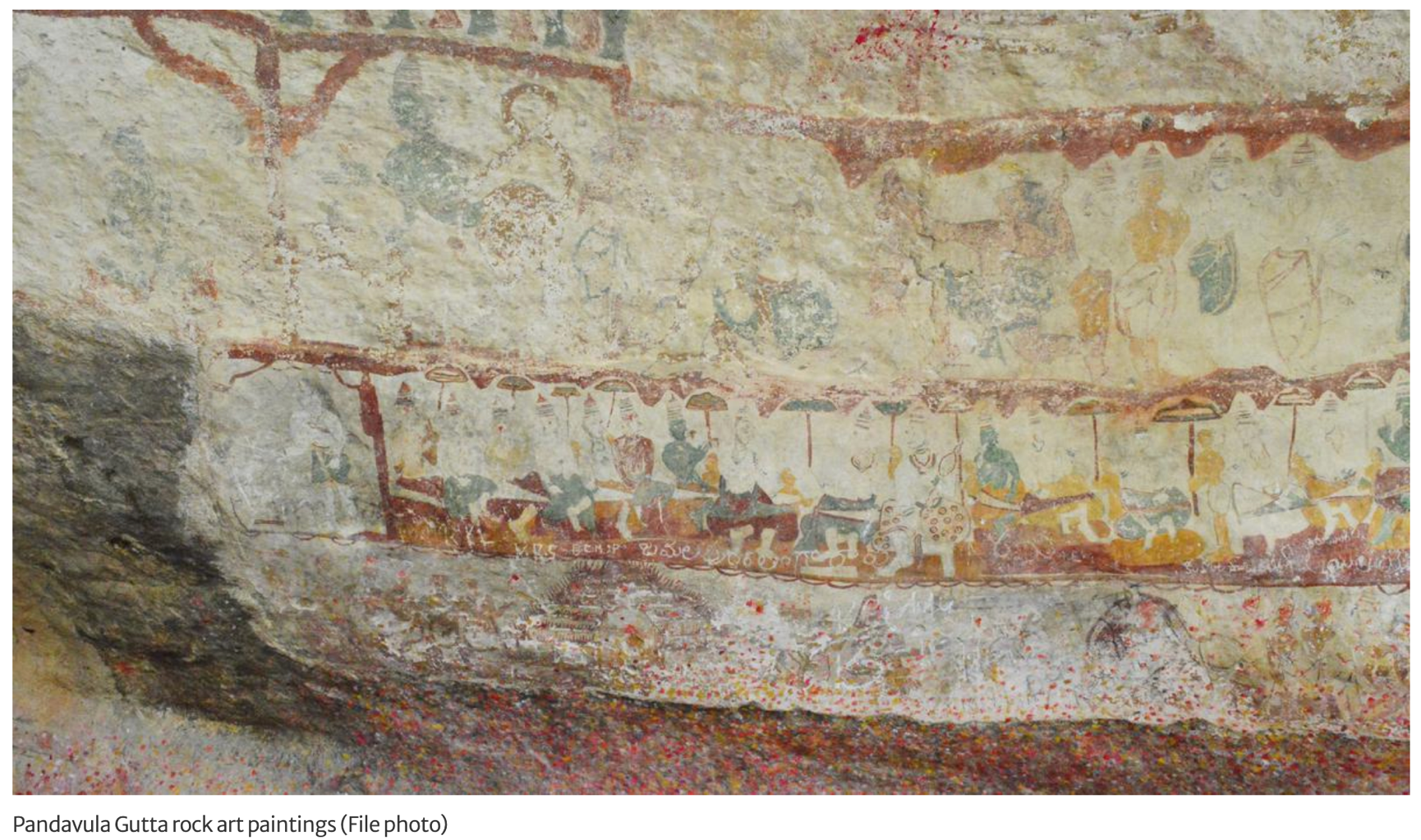





Disclaimer: Copyright infringement not intended.
Context
Pandavula Gutta, situated in the Bhupalpally district of Telangana, has recently gained recognition as the sole Geo-heritage site in the state.
Details
Key Features
Historical Significance:
Geo-Heritage Recognition:
Geo-Heritage Site
Geological Survey of India (GSI)
Other Sites in India
|
State |
Name of the site |
Location |
Brief description of the site |
|
Andhra Pradesh |
Volcanogenic bedded Barytes |
Mangampeta, Cuddapah Dist |
One of the largest baryte deposits of the world, formed through precipitation from volcanic vapours under submarine conditions and subaerial showering of ash and molten baryte lapilli. It has a reserve of over 74 million tonnes, constituting about 98% and 28% of the total known reserve of India and the world, respectively. |
|
Andhra Pradesh |
Eparchaean Unconformity |
Namalagundu, Anantapur District |
Separates the Proterozoic Nagari Quartzite from the oldest Archaean granite, representing a time gap of over 800 Ma. It signifies a period of remarkable quiescence in Earth's history with minimal structural disturbance and igneous activity. |
|
Andhra Pradesh |
Natural Geological Arch |
Tirumala hills, Chittoor District |
A unique geological marvel sculpted by geological agents like wind and water over thousands of years. The natural arch, measuring 8 meters in width and 3 meters in height, has been carved out of quartzite of the Cuddapah Supergroup over a long period of several thousand years. |
|
Andhra Pradesh |
Erra Matti Dibbalu |
Vishakhapatnam |
Rare red sand dunes formed over millions of years of geological processes. The dunes are located between Vishakhapatnam and Bhimunipatnam and consist of fragile reddish-brown concretion-bearing sand units, vulnerable to natural degradation. |
|
Kerala |
Laterite |
Angadipuram, Malapuram Dist. |
Laterite derived from acid charnockite, significant from an economic perspective due to associated mineral deposits of aluminum ore (bauxite), iron ore, and nickel ore. |
|
Kerala |
Varkala Cliff Section |
Thiruvanatapuram Dist. |
Exposes sedimentary rock formation of the Mio-pliocene Age, unique in the west coast of India. |
|
Tamil Nadu |
Fossil wood park |
Tiruvakkarai, Villupuram District |
National Fossil Wood Park with 200 fossil trees lying horizontally embedded in Cuddalore Sandstone of Mio-Pliocene age. |
|
Tamil Nadu |
National fossil wood park |
Sattanur, Perambalur Dist. |
Contains large trunks of petrified trees of Upper Cretaceous age, belonging to conifers that dominated the land vegetation during that period. |
|
Tamil Nadu |
Charnockite |
St. Thomas Mount, Madras |
Typical exposure of quartz-feldspar-hypersthene rock, believed to have important implications for the primordial crustal evolution of the earth. |
|
Tamil Nadu |
Badlands of Karai Formation with Cretaceous fossils along Karai |
Kulakkalnattam Section, Perambalur District |
Karai Formation exposed as badlands with conical mounds separated by gulleys, aiding in subdividing geologic history based on sedimentary breaks. |
|
Gujarat |
Sedimentary Structures Eddy Markings |
Kadan Dam, Panch Mahals Dist. |
Exposed eddy current markings believed to result from the dragging of a small limb of a larger floating log caught in a vortex or eddy current of a stream, or from the movement of a pebble. |
|
Rajasthan |
Sendra Granite |
Pali Dist. |
Unique granite formation sculpted by wind and water over millions of years. |
|
Rajasthan |
Barr Conglomerate |
Pali Dist. |
Composed of pebbles of quartzite and granite gneiss, set in a fine-grained pelitic matrix. |
|
Rajasthan |
Stromatolite Fossil Park |
Udaipur Dist. |
Largest and richest deposit of phosphorite associated with stromatolite, preserving evidence of early life on earth. |
|
Rajasthan |
Gossan in Rajpura-Dariba Mineralised belt |
Udaipur Dist. |
Resulted from extensive chemical weathering and oxidation of sulfide-sulphosalts ore bodies over prolonged geological periods under favorable climatic conditions. |
|
Rajasthan |
Stromatolite Park |
near Bhojunda, Chittaurgarh Dist. |
Exposure within the Bhagwanpura Limestone of the Lower Vindhyan age, showcasing stromatolites, structures produced by blue-green algae. |
|
Rajasthan |
Akal Fossil Wood Park |
Jaisalmer Dist. |
Petrified wood fossils of Lower Jurassic period, offering insights into the region's past vegetation and climate. |
|
Rajasthan |
Kishangarh Nepheline Syenite |
Ajmer Dist. |
Pluton emplaced along the core of an antiform of metamorphites, dated to 1590 million years to 1910 million years. |
|
Rajasthan |
Welded Tuff |
Jodhpur Dist. |
Product of volcanic emanations, composed of glass, quartz, and feldspar. |
|
Rajasthan |
Jodhpur Group – Malani Igneous Suite Contact |
Jodhpur Dist. |
Marks the last phase of igneous activity of Precambrian age in the Indian Subcontinent. |
|
Rajasthan |
Great Boundary Fault at Satur |
Bundi Dist. |
Characterized by a faulted boundary between Pre-Aravallis and Upper Vindhyans, exhibiting a zone of disruption constituted by parallel and oblique faults. |
|
Rajasthan |
Ramgarh crater |
Baran district |
3.5 km diameter crater suspected to have developed due to the impact of a large meteorite on Deccan Basaltic rocks of Cretaceous age. |
|
Rajasthan |
Zawar lead-zinc mine |
Udaipur district |
Major lead-zinc mine in Udaipur district. |
|
Maharashtra |
Lonar Lake |
Buldana Dist. |
Nearly circular crater suspected to have developed due to the impact of a large meteorite on Deccan Basaltic rocks of Cretaceous age. |
|
Chhattisgarh |
Lower Permian Marine bed at Manendragarh |
Sarguja Dist. |
Unique exposure of fossiliferous marine Permian rocks of Talchir Formation belonging to Gondwana Supergroup, with marine fauna dominated by pelecypods/lamellibranchs like Eurydesma and Aviculopecten. |
|
Karnataka |
Columnar Basaltic Lava, St Mary Islands |
Udupi Dist. |
Majestic array of multi-faced columns developed in the basalts of Deccan Trap, representing nature's exquisite handiwork. |
|
Karnataka |
Pillow lavas near Mardihalli |
Chitradurga Dist. |
Best example of pillow lavas formed when hot molten lava erupts under water and solidifies into roughly spherical or rounded pillow-shapes. |
|
Karnataka |
Peninsular Gneiss |
Lalbagh, Bangalore |
Exposes gneisses and related granitoids, dating back to 2500 to 3400 million years, significant for understanding the evolution of the terrain. |
|
Karnataka |
Pyroclastics & Pillow lavas, Kolar Gold fields |
Kolar Dist. |
Welded agglomerate of large fragments of various rocks, forming pyroclastic rocks. |
|
Himachal Pradesh |
Siwalik Fossil Park, Saketi |
Sirmur District |
Displays a rich collection of vertebrate fossils from Siwalik rocks of Plio-Pleistocene age. |
|
Odisha |
Pillow Lava in Iron ore belt |
Nomira, Keonjhar dist. |
Well-preserved pillow structures in basic lava, underlain by quartzite and overlain by shale, chart-shale, and banded hematite jasper. |
|
Jharkhand |
Plant Fossil bearing Inter-trappean beds of Rajmahal Formation |
Sahibganj dist. |
Exposes Gondwana Supergroup with fluviatile and lacustrine sediments, significant for understanding the continental sedimentary sequence of the region. |
|
Nagaland |
Nagahill Ophiolite |
Site near Pungro |
Represents an ophiolite complex in Nagaland. |
|
Sikkim |
Stromatolite bearing Dolomite/Limestone of Buxa Formation |
Mamley, near Namchi, South District |
Exposes dolomites profusely stromatolitic, providing insights into early life in Sikkim Himalaya. |
|
PRACTICE QUESTION Q. Discuss the significance of Geo-Heritage Sites (GHS) in India and their role in promoting geotourism and scientific research. How can the preservation and promotion of GHS contribute to sustainable development? Illustrate with examples. (250 Words) |




© 2026 iasgyan. All right reserved